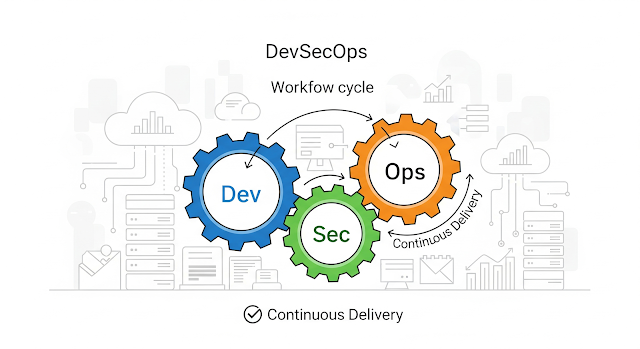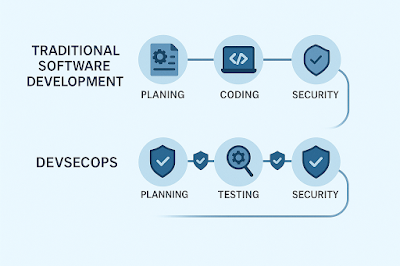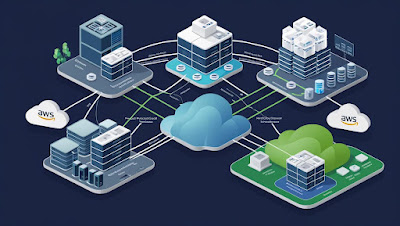DevSecOps: Integrating Security from Code to Cloud - Complete Guide 2025
With the ever-evolving digital world, hardening security in applications post-deployment is not a viable process anymore. DevSecOps, or the integration of security into the development life cycle itself, is now an absolute method for organizations to develop secure, secure applications at the same speed that they are developing them.
What is DevSecOps?
DevSecOps takes the DevOps culture to the next level by incorporating security activities at each stage of the software development lifecycle (SDLC). Unlike security being a separate phase and worked on by a different team, DevSecOps incorporates security at each stage of it, right from the code-writers to the infrastructure administrators.
The concept is straightforward: move security left. By fixing security issues upfront, organizations can eliminate vulnerabilities, prevent expenses, and improve time-to-market without compromising security posture.
The Cultural Shift: Dismantling Silos and Developing Security Awareness
The most frightening challenge that companies must hurdle in implementing DevSecOps is not tech—it's cultural. The dev environments are siloed with developers focusing on functionality, ops needing to deploy and be up, and security last to check and approve. Siloing is what creates friction, slows things down, and is then regarded as a speed bump instead of a booster.
The DevSecOps revolution demands a turnaround. Security never should be something that's being done to your code but something that's being done with your code. Developers need to think security people, study common vulnerabilities and secure coding standards and operations should incorporate security considerations into architecting infrastructure and deploying. Security practitioners should learn development pipelines and business imperatives and speak with others as humanitarians, not gatekeepers.
Creating this cultural shift is a gradual and intentional process. Successful companies are often starting by putting security champions on development teams—developers who receive extra security training and then serve as role models of secure behavior for other developers. Security champions close the knowledge gap and demystify security to development. Infrequent security training, lunch-and-leads, and hands-on workshops make security topics routine and integrate them into common development dialogue.
The DevSecOps Pipeline: Security at Every Stage
Code Development and Versioning
Security is built in at the code level. New DevSecOps deployment leverages SAST tools for code scanning for vulnerabilities as changes are being made by developers. For instance, GitHub's CodeQL and SonarQube can identify security vulnerabilities such as SQL injection flaws or hard coded credentials right in the IDE.
Netflix is a great example of this by using their own security software to scan the code repositories in real time. Their "Stethoscope" tool scans developer workstations for security compliance so security starts at secure development environments.
Continuous Integration and Testing
The CI/CD pipeline is the path to realizing DevSecOps. Security testing is performed along with function testing at build time. Dynamic application security testing tools such as OWASP ZAP or Burp Suite Professional are used and can be plugged into Jenkins or GitLab CI pipelines to scan the vulnerabilities of an application in running states.
Capital One's DevSecOps practice included security testing on CI/CD pipelines through automation. The cycles for security testing were shortened from weeks to hours, coverage was increased, and false positives were reduced through intelligent automation.
Infrastructure as Code (IaC) Security
Security for cloud infrastructure needs infrastructure configuration to be treated as code. Terraform, CloudFormation, and Ansible, to name just a few, must go through the same security scan as application code. Security scanners such as Checkov, Terrascan, and AWS Config can be used to scan infrastructure configurations and determine whether they are secure based on security best practices.
Airbnb employs security with IaC by utilizing dedicated tools that check Terraform configurations against their security controls prior to deployment. Misconfigurations that result in data leak or unauthorized access are therefore avoided.
Container and Kubernetes Security
Container security introduces an additional layer of complexity to DevSecOps. Container images need to be scanned for vulnerabilities and runtime security monitoring is a very critical requirement. Products such as Twistlock (now called Prisma Cloud), Aqua Security, and Falco offer end-to-end-container-security solutions.
Spotify's security strategy for containers involves scanning all container images automatically for vulnerability, runtime monitoring to monitor for malicious activity, and network segmentation policies based on Kubernetes network policies. Their use case demonstrates how containerized environments at scale can be safe without compromising deployment speed.
Measuring Success: DevSecOps Metrics That Matter
Testing DevSecOps without metrics is like driving a blindfolded car—you're going somewhere, but you don't know if you're headed where you'd prefer to go. Smart companies establish specific metrics ahead of time so they can track their journey and where they're lagging. DevSecOps success is based on more than security metrics like vulnerability counts. Mean time to remediation (MTTR) for security incidents indicates how quickly your team is responding to attacks, and the security issue catch ratio in development to production indicates if your "shift left" is truly working or not. Deployment frequency and lead time metrics hold back security improvement from slowing delivery. Most critically, developer feedback in surveys might indicate if security practices are being followed or merely tolerated.
Well-functioning teams also keep an eye on security debt—a backlog of recorded security issues that haven't been resolved yet. Similar to technical debt, security debt occurs and is more expensive to resolve the longer it goes unaddressed. By keeping an eye on and paying attention to security debt on a regular basis, teams can make intelligent choices regarding when to spend money on security improvement versus additional functionality. The goal is not to eliminate all security debt (which in most cases is impossible), but to control it at reasonable levels and continually improve the security posture of new code.
Real-World Implementation: Industry Leader Lessons
Case Study: Capital One's DevSecOps Journey
Capital One embarked on its transformation after their 2019 data breach exposed them to the necessity of converged security practices. They initiated an end-to-end DevSecOps practice consisting of:
Automated in-pipeline security testing for every CI/CD pipeline
Live security monitoring and alerting
Security champions on development teams
Round-the-clock security-trained developers
The outcome was amazing: 80% fewer security bugs making it to production, 60% faster resolution of security issues, and happier developers with less slowdown caused by security.
Netflix's Approach to Cloud Security
Netflix's cloud-native security architecture centers around cutting-edge DevSecOps practices. Their "Chaos Monkey" tool, though used primarily to test for resiliency, tests security controls in failure mode too. They have also released open-source versions of several of their security tools such as Security Monkey for AWS security scanning and Scumblr for collecting security intelligence.
Best Practices for DevSecOps Implementation
Successful DevSecOps requires technical and cultural transformation. Begin with automated security scanning within current pipelines, progressing incrementally towards greater coverage and maturity. Integrate security training into development teams and enforce rigorous security expectations as part of every project's kickoff.
Create security as code, security policy, and configuration on par with application code. Use infrastructure as code technologies to enable consistent, auditable security configurations across environments.
Conclusion
DevSecOps is a game changer in application security. By integrating security into the complete development lifecycle, organizations can develop more secure applications without sacrificing speed and agility expected from today's business. Success cases of Netflix, Capital One, and other industry verticals prove that DevSecOps is not a theory—its a proven practice with measurable outcomes.
As cloud adoption and cyber attacks grow and intensify, organizations embracing DevSecOps will be well-placed to safely protect their applications, information, and consumers and enable competitive differentiation through fast, secure software deployment.




.png)




Comments
Post a Comment